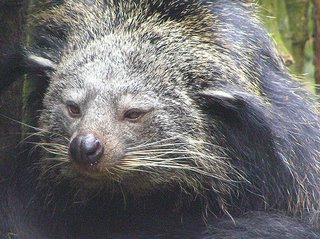When we think of communication, foremost on our mind is our own sophisticated means of language - writing and speaking mainly - communicating ideas or concepts through our manipulation of sound and symbology.
Evolutionarily speaking, this is a recent development; there are certainly no written documents from the time of the Australpithocenes or Homo erectus, and scientists can only guess at their ability to use a complex language.
Scent marking, then, is a much more ancient, much more prevalent form of communication between animals. Even humans use scents for communicative purposes - we use perfumes to send a message to others telling of our state of cleanliness (or lack of) - however, our vocal language has largely replaced the necessity of scent communication.
The binturong, like other civets (cat-like, mostly arboreal carnivores), leaves scent markings all over tree branches, limbs and leaves during their nighttime travels through the dense rainforests of south Asia. The markings are chemical messages to other binturongs and can communicate anything from territory ownership to reproductive maturity; some may be just a simple hello.
They secrete a oily substance from a special gland located in their hind section (called simply a perineal gland - perineal refers to the region of the body more than any specific function - the groin area). The binturong has been observed dragging the gland across tree limbs and other surfaces, as well as marking singled-out "posts." When the binturong applies its olfactory message to these special surfaces, there is an equally special (quasi-ritualistic) position into which it moves (such as an inverted, "sloth-like" position for a certain diagonal limb).
The male binturong also uses its tail to sop up its own urine, another important scent messenger. Its tail assists the animal in climbing (prehensility) and is naturally involved in embracing limbs and branches for balance, so surfaces upon which the binturong climbs are automatically marked.
I think it's obvious that binturongs might not be the best choice of pet for western households.* It's frustrating enough when the housecat sprays; bints can probably do some lasting damage to your favorite rug.
But, rather than be repulsed by these creatures, it is important to recognize that they manipulate the laws of physical world to create interpretable messages for each other just as we do. I am not equating our language with theirs, but the purpose is largely the same; it is quite obvious that throughout the millenia, natural selection has valued communication - chemical and otherwise - in response to the rigors of the environment.
*In southern Asia, many people do keep binturongs as pets. They are not very aggressive animals, and are easily domesticated (mostly).
Resources:
Kleiman, D.G. 1974. Scent marking in the binturong, Arctictis binturong. J. Mamml, 55:224-227.
Photo by belgianchocolate.

Keepers of binturongs report that the animals smell like corn chips.
Very good blog